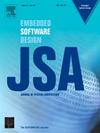SMCCA:一种面向无人驾驶车辆网络的分片多任务协同共识算法
IF 4.1
2区 计算机科学
Q1 COMPUTER SCIENCE, HARDWARE & ARCHITECTURE
引用次数: 0
摘要
共识机制是现代网络协作系统中的一项关键技术,在无人驾驶汽车网络等新兴场景中发挥着关键作用。然而,随着无人系统复杂性和规模的不断升级,现有共识算法暴露出两个主要瓶颈:(1)全局共识机制导致的高通信开销;(2)对复杂任务间约束的处理不足,严重限制了无人系统的实际部署。为了解决这些挑战,我们提出了一种分片多任务协作共识算法(SMCCA),该算法采用分而治之的方法将传统的全局共识问题解耦为可并行的局部共识子问题,从而优化通信成本并增强任务协调。具体而言,SMCCA通过三个核心机制确保uvn内部的有效协作。首先,该算法使用分片架构将无人设备划分为多个自治但可互操作的集群,其中领导分片充当全局协调器,以实现细粒度的跨分片任务合作。其次,构建任务关系图(Task Relationship Graph, TRG),精确量化任务间的依赖关系和冲突;在此基础上,采用分层拓扑排序算法生成无约束交互的最优执行序列。第三,建立了基于有向无环图(DAG)的分层全局任务视图,以支持有效的故障恢复和一致的状态维护。实验结果表明,在分布在四个分片上的256个节点的网络中,SMCCA实现了每秒11,835个任务的吞吐量,平均延迟约为0.5 s,显著优于现有的共识算法。本文章由计算机程序翻译,如有差异,请以英文原文为准。
SMCCA: A sharded multi-task collaborative consensus algorithm for unmanned vehicle networks
Consensus mechanisms are a critical technology in modern networked collaborative systems and play a pivotal role in emerging scenarios such as Unmanned Vehicle Networks (UVNs). However, the escalating complexity and scale of unmanned systems have exposed two principal bottlenecks in existing consensus algorithms: (1) high communication overhead resulting from global consensus mechanisms, and (2) inadequate handling of intricate inter-task constraints, which severely limits the practical deployment of UVNs. To address these challenges, we propose a Sharded Multi-task Collaborative Consensus Algorithm (SMCCA), which employs a divide-and-conquer approach to decouple traditional global consensus problems into parallelizable local consensus sub-problems, thereby optimizing communication costs and enhancing task coordination. Specifically, SMCCA ensures efficient collaboration within UVNs through three core mechanisms. First, the algorithm partitions unmanned devices into multiple autonomous yet interoperable clusters using a sharding architecture, where leader shards act as global coordinators to enable fine-grained cross-shard task cooperation. Second, a Task Relationship Graph (TRG) is constructed to precisely quantify the dependencies and conflicts among tasks. Based on this, a hierarchical topological sorting algorithm is applied to generate an optimal execution sequence without constrained interactions. Third, a hierarchical global task view based on a Directed Acyclic Graph (DAG) is established to support efficient fault recovery and consistent state maintenance. Experimental results demonstrate that in a network with 256 nodes distributed across four shards, SMCCA achieves a throughput of 11,835 tasks per second and an average latency of approximately 0.5 s, significantly outperforming existing consensus algorithms.
求助全文
通过发布文献求助,成功后即可免费获取论文全文。
去求助
来源期刊

Journal of Systems Architecture
工程技术-计算机:硬件
CiteScore
8.70
自引率
15.60%
发文量
226
审稿时长
46 days
期刊介绍:
The Journal of Systems Architecture: Embedded Software Design (JSA) is a journal covering all design and architectural aspects related to embedded systems and software. It ranges from the microarchitecture level via the system software level up to the application-specific architecture level. Aspects such as real-time systems, operating systems, FPGA programming, programming languages, communications (limited to analysis and the software stack), mobile systems, parallel and distributed architectures as well as additional subjects in the computer and system architecture area will fall within the scope of this journal. Technology will not be a main focus, but its use and relevance to particular designs will be. Case studies are welcome but must contribute more than just a design for a particular piece of software.
Design automation of such systems including methodologies, techniques and tools for their design as well as novel designs of software components fall within the scope of this journal. Novel applications that use embedded systems are also central in this journal. While hardware is not a part of this journal hardware/software co-design methods that consider interplay between software and hardware components with and emphasis on software are also relevant here.
 求助内容:
求助内容: 应助结果提醒方式:
应助结果提醒方式:


